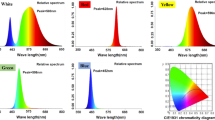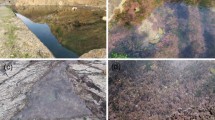Abstract
A non-thecate dinoflagellate, Gymnodinium splendens, was studied in a 12 d laboratory experiment in 2.0x0.25 m containers in which light, temperature, and nutrients could be manipulated. Under a 12 h light: 12 h dark cycle, the dinoflagellates exhibited diurnal vertical migrations, swimming downward before the dark period began and upward before the end of the dark period. This vertical migration probably involved geotaxis and a diel rhythm, as well as light-mediated behavior. The vertical distribution of nitrate affected the behavior and physiology of the dinoflagellate. When nitrate was present throughout the container, the organisms resembled those in exponential batch culture both in C:N ratios and photosynthetic capacity (Pmax); moreover, they migrated to the surface during the day. In contrast, when nitrate was depleted, C:N ratios increased, Pmax decreased, and the organisms formed a subsurface layer at a depth corresponding to the light level at which photosynthesis saturated. When nitrate was present only at the bottom of the tank, C:N ratios of the population decreased until similar to those of nutrient-saturated cells and Pmax increased; however, the dinoflagellates behaved the same as nutrient-depleted cells, forming a subsurface layer during the light period. Field measurements revealed a migratory subsurface chlorophyll maximum layer dominated by G. splendens. It was just above the nitracline during the day, and in the nitracline during the night, which concurs with our laboratory observations.
Similar content being viewed by others
Literature Cited
Anderson, G. C. and R. P. Zeutschel: Release of dissolved organic matter by marine phytoplankton in coastal and offshore areas of the northeast. Pacific Ocean. Limnol. Oceanogr. 15, 402–407 (1970)
Blasco, D.: Observations on the diel migration of marine dinoflagellates off the Baja California Coast. Mar. Biol. 46, 41–47 (1978)
Cullen, J. J. and R. W. Eppley: Chlorophyll maximum layers of the Southern California Bight and possible mechanisms of their formation and maintenance. Oceanol. Acta 4 23–32 (1981)
Cullen, J. J. and E. H. Renger: Continuous measurement of the DCMU-induced fluorescence response of natural phytoplankton populations. Mar. Biol. 53, 13–20 (1979)
Eppley, R. W. and W. G. Harrison. Physiological ecology of Gonyaulax polyedra, a red water dinoflagellate off Southern California. In: Proceedings of First International Conference on Toxic Dinoflagellate Blooms, pp 11–22. Ed. by U. R. LeCicero. Wakefield, Mass.: Massachusetts Science and Technology Foundation 1974
Eppley, R. W., R. W. Holmes and J. D. H. Strickland: Sinking rates of marine phytoplankton measured with a fluorometer. J. exp. mar. Biol. Ecol. 1, 191–208 (1967)
Eppley, R. W., O. Holm-Hansen and J. D. H. Strickland: Some observations on the vertical migration of dinoflagellates. J. Phycol. 4, 333–340 (1968)
Eppley, R. W. and E. H. Renger: Nitrogen assimilation of an oceanic diatom in nitrogen-limited continuous culture. J. Phycol. 10, 15–23 (1974)
Forward, R. B.: Light and diurnal vertical migration: photobehavior and photophysiology of plankton. Photochem. Photobiol. Rev. 1, 157–209 (1976)
Harris, G. P., S. I. Heaney and J. F. Talling: Physiological and environmental constraints in the ecology of the planktonic dinoflagellate Ceratium hirundinella. Freshwat. Biol. 9, 413–428 (1979)
Hasle, G. R.: Phototactic vertical migration in marine dinoflagellates. Oikos 2, 162–175 (1950)
Heaney, S. I. and R. W. Eppley: Light, temperature, and nitrogen as interacting factors affecting diel vertical migrations of dinoflagellates in culture. J. Plankton Res. (In press)
Heaney, S. I. and T. I. Furnass: Laboratory models of diel vertical migration in the dinoflagellate Ceratium hirundinella. Freshwat. Biol. 10, 163–170 (1980)
Heaney, S. I. and J. F. Talling: Dynamic aspects of dinoflagellate distribution patterns in a small productive lake. J. Ecol. 68, 75–94 (1980)
Holligan, P. M.: Dinoflagellate blooms associated with tidal fronts around the British Isles. In: Toxic dinoflagellate blooms, pp 249–256. Ed. by D. L. Taylor and H. H. Seliger. New York: Elsevier 1979
Kamykowski, D.: The growth response of a model Gymnodinium splendens in stationary and wavy water columns. Mar. Biol. 50, 289–303 (1979)
Kamykowski, D.: Laboratory experiments on the diurnal vertical migration of marine dinoflagellates through temperature gradients. Mar. Biol. 62, 57–64 (1981)
Kamykowski, D. and S.-J. Zentara: The diurnal vertical migration of motile phytoplankton through temperature gradients. Limnol. Oceanogr. 22, 148–151 (1977)
Kiefer, D. A. and R. Lasker: Two blooms of Gymnodinium splendens, an unarmored dinoflagellate. Fish. Bull. U.S. 73, 675–678 (1975)
Lasker, R.: Field criteria for survival of anchovy larvae: the relation between inshore chlorophyll maximum layers and successful first feeding. Fish. Bull. U.S. 73, 453–462 (1975)
Myers, J.: Physiology of the algae. A. Rev. Microbiol. 5, 157–180 (1951)
Prézelin, B. B., B. W. Meeson and B. M. Sweeney: Characterization of photosynthetic rhythms in marine dinoflagellates. I. Pigmentation, photosynthetic capacity and respiration. Pl. Physiol., Lancaster 60, 384–387 (1977)
Provasoli, L.: Recent progress, an overview. In: Toxic dinoflagellate blooms, pp 1–14. Ed. by D. L. Taylor and H. H. Seliger. New York: Elsevier 1979
Redfield, A. C., B. H. Ketchum and F. A. Richards: The influence of organisms on the composition of seawater, pp 26–77.
Seliger, H. H., M. A. Tyler and K. R. McKinley: Phytoplankton distributions and red tides resulting from frontal circulation patterns. In: Toxic dinoflagellate blooms, pp 239–248. Ed. by D. L. Taylor and H. H. Seliger. New York: Elsevier 1979
Sharp, J. H.: Improved analysis for “particulate” organic carbon and nitrogen from seawater. Limnol. Oceanogr. 19, 984–989 (1974)
Sokal, R. R. and F. J. Rohlf: Biometry. The principles and practice of statistics in biological research, 776 pp. San Francisco: W. H. Freeman & Co. 1969
Solórzano, L.: Determination of ammonium in natural waters by the phenol hypochlorite method. Limnol. Oceanogr. 14, 799–801 (1969)
Staker, R. D. and S. F. Bruno: Diurnal vertical migration in marine phytoplankton. Botanica mar. 23, 167–172 (1980)
Steele, J. H.: A study of production in the Gulf of Mexico. J. mar. Res. 22, 211–222 (1964)
Strickland, J. D. H., O. Holm-Hansen, R. W. Eppley and R. J. Linn: The use of a deep tank in plankton ecology. I. Studies of the growth and composition of phytoplankton crops at low nutrient levels. Limnol. Oceanogr. 14, 23–34 (1969)
Strickland, J. D. H. and T. R. Parsons: A practical handbook of seawater analysis, 2nd ed. Bull. Fish. Res. Bd Can. 167, 1–310 (1972)
Tate, M. W. and R. C. Clelland: Nonparametric and shortcut statistics, 171 pp. Danville, Illinois: Interstate Printers & Publishers 1957
Tyler, M. A. and H. H. Seliger: Annual subsurface transport of a red tide dinoflagellate to its bloom area: water circulation patterns and organism distribution in the Chesapeake Bay. Limnol. Oceanogr. 23, 227–246 (1978)
Weiler, C. S. and D. M. Karl: Diel changes in phased-dividing cultures of Ceratium furca (Dinophyceae): nucleotide triphosphates, adenylate energy charge, cell carbon, and patterns of vertical migration. J. Phycol. 15, 384–391 (1979)
Author information
Authors and Affiliations
Additional information
Communicated by N.D. Holland, La Jolla
Rights and permissions
About this article
Cite this article
Cullen, J.J., Horrigan, S.G. Effects of nitrate on the diurnal vertical migration, carbon to nitrogen ratio, and the photosynthetic capacity of the dinoflagellate Gymnodinium splendens . Mar. Biol. 62, 81–89 (1981). https://doi.org/10.1007/BF00388169
Accepted:
Issue Date:
DOI: https://doi.org/10.1007/BF00388169




